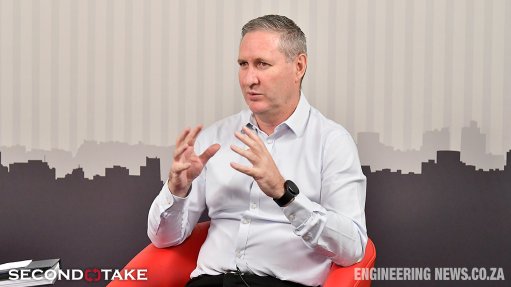Sibanye-Stillwater, Wits partner to digitalise mining industry
JOHANNESBURG (miningweekly.com) – Gold miner Sibanye-Stillwater has reaffirmed its commitment to ensuring safer and more productive mines by continuing its ongoing partnership with the University of the Witwatersrand’s (Wits’) Mining Institute with the launch on Wednesday of the Sibanye-Stillwater Digital Mining Laboratory (DigiMine).
DigiMine is a simulated mining environment in the Chamber of Mines building on the West Campus of Wits. Its facilities include a vertical shaft in a stairwell, a tunnel and stope in the basement, and a range of communication and digital systems to enable research that will “create the mine of the future.”
Sibanye’s total investment between 2015 and 2020 will amount to R27.5-million. Of the miner's most recent investment of R15-million, R9-million will be used to fund DigiMine research.
In addition, Wits Vice-Chancellor Professor Adam Habib and Wits School of Mining head Professor Cuthbert Musingwini will each allocate R3-million for student support and strategic projects.
Sibanye CEO Neal Froneman described the launch of DigiMine as “the start of a new era in digitalised hard rock mining,” and noted that the aim is to challenge the perception of mining as an unsophisticated, unsafe and laborious industry, while also changing the way the local industry operates.
He told Mining Weekly Online, “we need to change the way we mine in South Africa. We’ve mined the same way for the last 100 years.” He noted that while there had been some technological advancements in hard rock drilling, the industry had “plateaued”, and productivity had decreased as a result.
“Everything we’ve done until now (in terms of the local industry adopting and creating technology), will make a marginal difference. This partnership, and the research it is advancing, provides a real opportunity to improve hard rock mining.”
Froneman envisioned a modernised mining industry able to optimally extract and beneficiate the country’s natural resources, “for the benefit of all stakeholders, not just shareholders.”
Wits Mining Institute (WMI) director Professor Fred Cawood stated that government should “look after” mining as it contributes more than double its gross domestic product (7%) to the fiscus (15%) – “more than its fair share.” However, he stressed that it was also important for mining to “look after itself”, adopting innovative production, efficiency, and deriving value, thereby becoming sustainable and remaining relevant in the coming decades.
Cawood elaborated on some of the research being undertaken at the DigiMine, noting that the research is focused on five core themes, namely: reliable multipurpose underground communication; underground mapping and navigation; seismicity and mine design; real-time integration of technologies, and skills-based research.
In a broad sense, the DigiMine programme intends to transfer surface digital technologies to underground operations.
He told Mining Weekly Online that the WMI had smaller programmes within these broader themes, such as the communications research including investigations into wireless sensor networks that enable different sources of communication (both voice- and data-based), which would enable more effective search and rescue operations, as it could be used for positioning and communication purposes. It would also have the ability to “self-heal”.
“Our exciting research already includes projects on systems for underground . . . risk monitoring, positioning and navigation similar to GPS . . . our interventions will explore any innovations that can apply real-time digital solutions for reducing mining risk and increasing mining efficiency,” said Cawood.
The ‘Future World of Work’ initiative forms part of the skills theme. Cawood explained that the types of technologies being developed would require a range of skills, which, in some cases, have yet to be developed.
Other “world-first” initiatives include visual integration of mining technology systems, and underground remote sensing through unmanned aerial vehicles using scanning applications.
The weeklong programme to celebrate the launch of the DigiMine included a two-day seminar which showcased the work of some of the postgraduate research students and partner organisations, while keynotes on the digital mining theme were delivered by Sibanye and the national University of Sciences and Technology in Pakistan – another of the DigiMine initiative’s partners.
Comments
Announcements
What's On
Subscribe to improve your user experience...
Option 1 (equivalent of R125 a month):
Receive a weekly copy of Creamer Media's Engineering News & Mining Weekly magazine
(print copy for those in South Africa and e-magazine for those outside of South Africa)
Receive daily email newsletters
Access to full search results
Access archive of magazine back copies
Access to Projects in Progress
Access to ONE Research Report of your choice in PDF format
Option 2 (equivalent of R375 a month):
All benefits from Option 1
PLUS
Access to Creamer Media's Research Channel Africa for ALL Research Reports, in PDF format, on various industrial and mining sectors
including Electricity; Water; Energy Transition; Hydrogen; Roads, Rail and Ports; Coal; Gold; Platinum; Battery Metals; etc.
Already a subscriber?
Forgotten your password?
Receive weekly copy of Creamer Media's Engineering News & Mining Weekly magazine (print copy for those in South Africa and e-magazine for those outside of South Africa)
➕
Recieve daily email newsletters
➕
Access to full search results
➕
Access archive of magazine back copies
➕
Access to Projects in Progress
➕
Access to ONE Research Report of your choice in PDF format
RESEARCH CHANNEL AFRICA
R4500 (equivalent of R375 a month)
SUBSCRIBEAll benefits from Option 1
➕
Access to Creamer Media's Research Channel Africa for ALL Research Reports on various industrial and mining sectors, in PDF format, including on:
Electricity
➕
Water
➕
Energy Transition
➕
Hydrogen
➕
Roads, Rail and Ports
➕
Coal
➕
Gold
➕
Platinum
➕
Battery Metals
➕
etc.
Receive all benefits from Option 1 or Option 2 delivered to numerous people at your company
➕
Multiple User names and Passwords for simultaneous log-ins
➕
Intranet integration access to all in your organisation


















